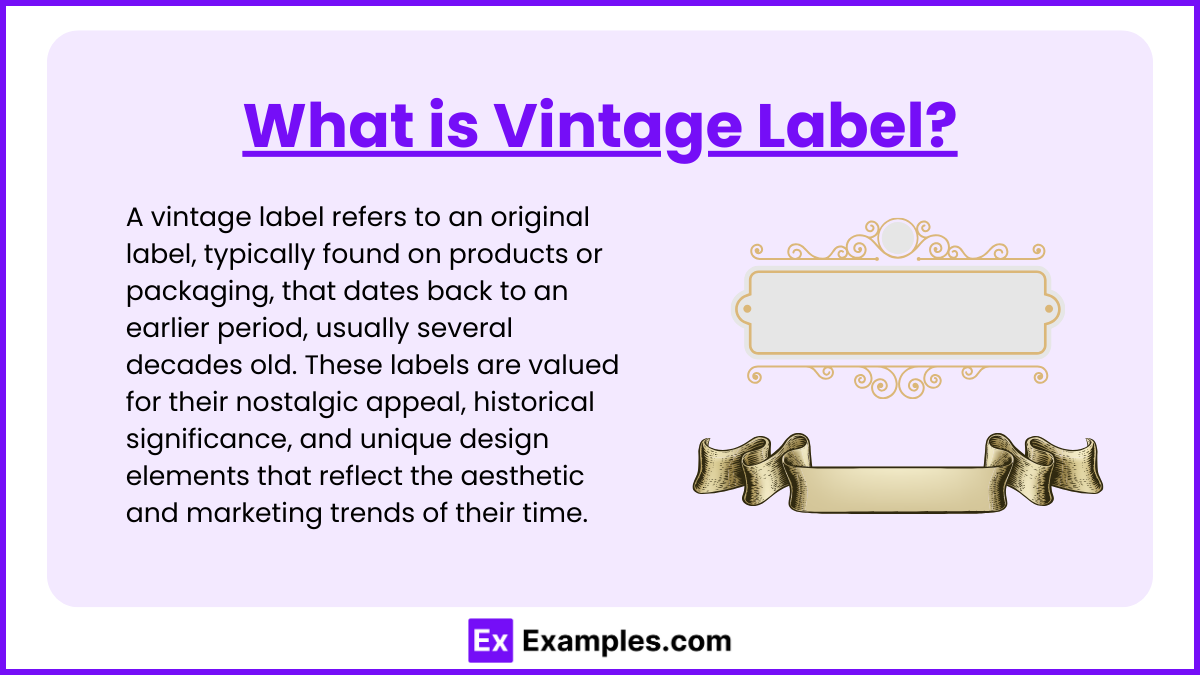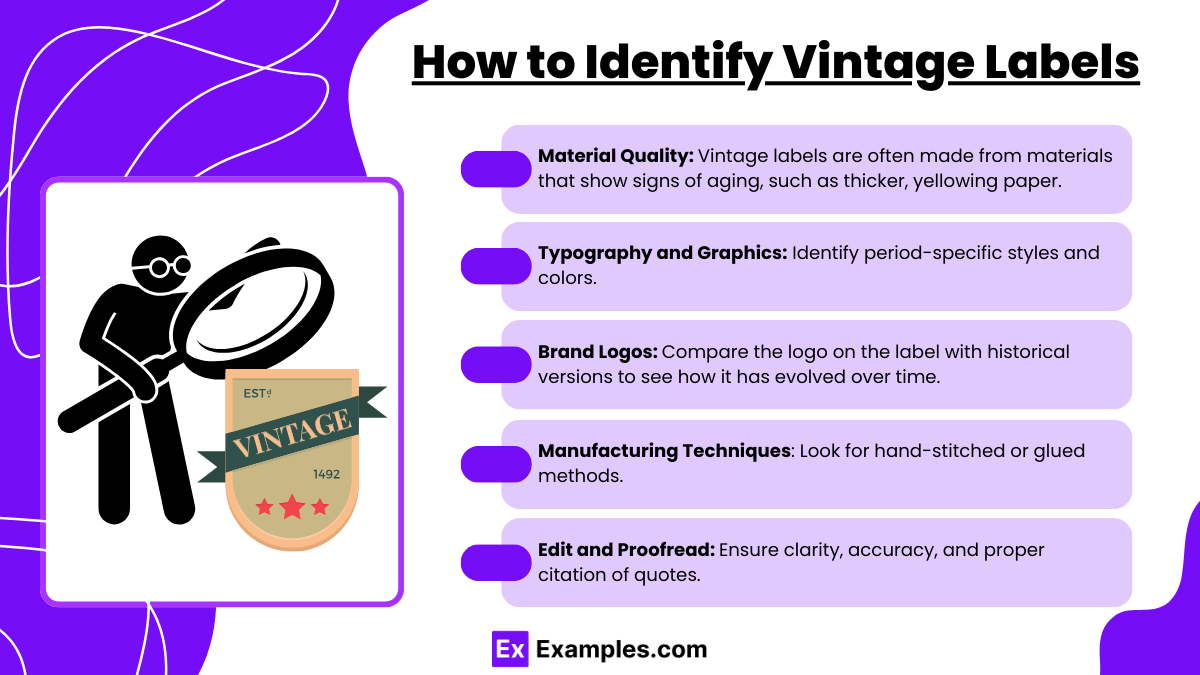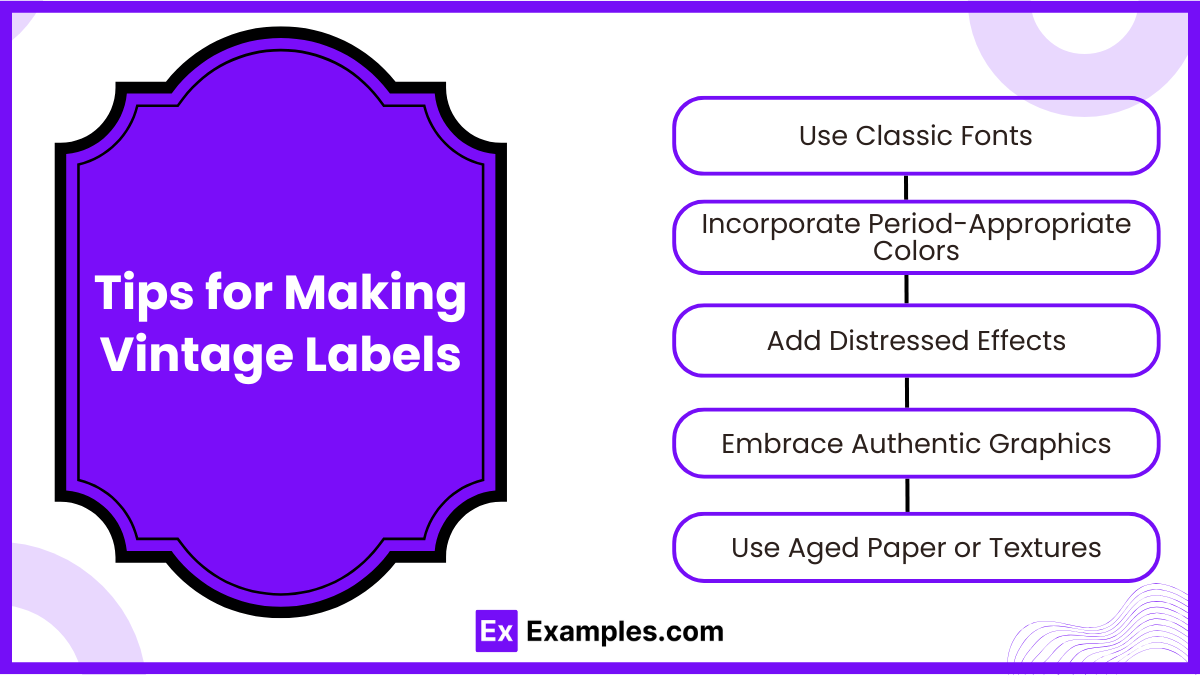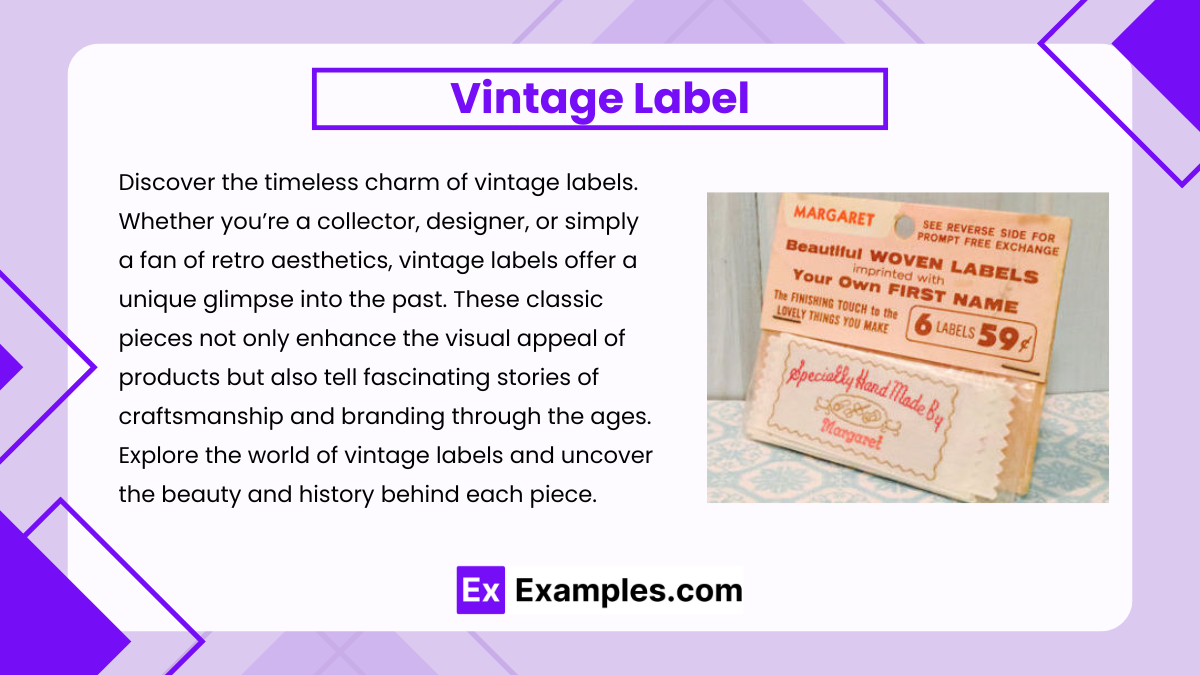50+ Vintage Label Examples to Download
Discover the timeless charm of vintage labels. Whether you’re a collector, designer, or simply a fan of retro aesthetics, vintage labels offer a unique glimpse into the past. These classic pieces not only enhance the visual appeal of products but also tell fascinating stories of craftsmanship and branding through the ages. Explore the world of vintage labels and uncover the beauty and history behind each piece.
What is Vintage Label?

Vintage Label Examples
Vintage Labels for Clothing
- Levi’s “Big E” Label: Used until 1971, the capital ‘E’ in LEVI’S on the red tab indicates jeans from the era.
- Chanel Boutique: Features a simple, elegant script, iconic to mid-20th century Chanel garments.
- Christian Dior “New Look” Era: Labels from the 1940s-1950s, typically marked with “Christian Dior” in distinctive script, signifying the revolutionary New Look designs.
- Pendleton Woolen Mills: Vintage labels, especially pre-1970s, showcase unique fonts and sometimes intricate borders, known for their wool shirts and jackets.
- Alfred Shaheen Hawaiian Shirts: Mid-century labels that feature vibrant prints and the designer’s name, renowned for popularizing the Hawaiian shirt on the mainland.
- Gucci with “GG” Logo: Labels from before the 1980s often feature the famous interlocking GG logo and a simple design, denoting luxury and craftsmanship.
- Burberry’s “Prorsum” Knight: Includes the equestrian knight logo, found on pieces from the mid-20th century, a mark of classic British style.
- Schott NYC: Famous for their leather jackets, vintage Schott labels are simple and typically include the company’s name and the Made in USA designation.
- Hermès Paris: Often just the company name in a clean font, vintage Hermès labels from bags and scarves are understated and synonymous with high-end luxury.
- Yves Saint Laurent Rive Gauche: Labels from the 1960s and 1970s feature the designer’s full name in a distinctive font, associated with Parisian chic and modern femininity.
- Brooks Brothers: Known for classic American menswear, vintage Brooks Brothers labels often feature simple, elegant typography on a golden or cream background.
- Burberry: Classic Burberry pieces, particularly the trench coats, feature labels with the iconic equestrian knight logo.
Vintage Labels for Sale
- Vintage Wine Labels: These labels are highly collectible, featuring intricate artwork and typography that reflect the wine’s origin and age.
- Classic Band T-Shirt Labels: Collectors often seek out original band t-shirts from the 70s and 80s, which have the band’s authentic merchandise label.
- Historic Apothecary Labels: These often come from old medicine bottles and feature elaborate designs and old-fashioned fonts.
- Vintage Travel Luggage Labels: Once used to advertise exotic travel destinations, these colorful and graphic labels are popular among collectors.
- Antique Crate Labels: Used on wooden crates for fruits and vegetables, these labels are prized for their vibrant graphics and retro charm.
- Old Cigar Box Labels: These labels are intricate and decorative, often featuring gold leaf and embossed designs.
- Vintage Clothing Labels from Iconic Brands: Labels from brands like Chanel, Dior, and Levi’s from specific eras are sought after for their historical and aesthetic value.
- Classic Car Labels and Emblems: Collectible labels from vintage cars, including decals and badges, are popular in automotive collectibles.
- Old Cosmetic Labels: Vintage labels from beauty products, showcasing the glam and style of their production era.
- Historical Camera Labels: Labels from old cameras and photography equipment, which appeal to photography enthusiasts and collectors.
Vintage Labels for Gifts Tags
- Vintage Wine Bottle Labels: Cut and use these sophisticated labels for gift tags on bottles of wine or gourmet food baskets.
- Old Travel Stickers: Attach these colorful labels to luggage or travel-themed gift wrapping.
- Retro Seed Packets: Perfect for gardeners, use these labels on gifts related to gardening or nature.
- Vintage Fashion Labels: Attach a piece of clothing’s original label to fashion-related gifts or use in sewing and crafts presentations.
- Historic Postage Stamps: Use these stamps as tiny, intricate gift tags for small packages or envelope-style gift wraps.
- Classic Book Spine Labels: Ideal for book lovers, use these labels on gifts wrapped in pages of old books or alongside literary gifts.
- Antique Apothecary Labels: Great for homemade spa and beauty gifts, use these labels to enhance the vintage feel of your packages.
- Old Cigar Box Labels: Their elaborate designs make them excellent for gifts that aim to evoke a sense of nostalgia or luxury.
- Vintage Cheese Labels: Attach these to a cheese board gift, or use them for a gourmet food basket.
- Decorative Perfume Bottle Labels: These ornate labels can be used for gifts of perfumes or personal care items, adding a touch of vintage elegance.
Vintage Label for Journal
- Classic Typewriter Labels: Mimic old typewriter ribbon tins with labels featuring vintage fonts and muted colors.
- Old Map Labels: Use labels inspired by aged maps, ideal for travel journals or adventure logs.
- Vintage Pharmacy Labels: Incorporate apothecary-style labels with ornate designs for a mysterious or historical diary.
- Antique Book Plates: Adapt labels from the inside covers of old books, perfect for personalizing your journal.
- Victorian Floral Labels: Feature intricate floral designs from the Victorian era, lending elegance and a feminine touch to your journal.
- Art Nouveau Style Labels: Employ the flowing, organic lines of Art Nouveau for a visually striking cover.
- Retro Radio Labels: Draw inspiration from mid-century radio labels, suitable for a music lover’s journal.
- Vintage Luggage Tags: Use the look of old luggage tags for a journal that records travels or daily adventures.
- Classic Film Labels: For movie buffs, create labels styled after old film canisters or cinema tickets.
- Old-Fashioned Recipe Labels: Perfect for a recipe or cooking journal, use labels styled like those from vintage food cans or spice jars.
Vintage Label for Scrapbook
- Vintage Postcard Labels: Use designs inspired by old postcards, perfect for scrapbook pages documenting travels or special locations.
- Old Cinema Ticket Stubs: Incorporate designs from vintage movie tickets, ideal for pages about movie nights or film-related memories.
- Historic Advertisement Labels: Utilize labels inspired by early 20th-century advertisements, great for a retro or marketing-themed scrapbook.
- Antique Botanical Labels: Feature beautiful, detailed illustrations of plants and flowers from vintage botanical books.
- Vintage Toy Labels: Use playful, colorful labels from classic toys for a scrapbook dedicated to childhood or family memories.
- Retro Food Product Labels: Include designs from old food packaging, perfect for pages about cooking experiences or family meals.
- Historical Train Ticket Labels: Design your pages with labels styled after vintage train tickets for a travel-themed scrapbook.
- Vintage Fabric Patterns: Use labels that mimic the patterns and textures of vintage fabrics, ideal for a fashion or arts and crafts scrapbook.
- Old School Labels: Incorporate labels from vintage school books or supplies, suitable for pages about education or personal growth.
- Antique Sporting Event Tickets: For sports enthusiasts, use designs inspired by old game tickets or sports memorabilia.
The Historical Significance of Vintage Labels
Vintage labels hold significant historical value as they provide insights into the fashion, marketing, and economic conditions of their times. These labels act as artifacts that capture the essence of different eras, reflecting changes in design trends, consumer preferences, and production techniques. For instance, labels from the early 20th century might showcase intricate designs and luxurious materials, indicating a period of opulence, while those from wartime periods could display simpler designs and materials due to resource constraints.
Moreover, vintage labels help trace the evolution of branding and advertising strategies. Early labels often featured detailed artwork and ornate typography, which were key to attracting consumers before the digital age. As time progressed, labels became more streamlined and logo-centric, mirroring the shift towards modernism in design.
Collectors and historians value vintage labels not only for their aesthetic appeal but also for their ability to offer a tangible connection to the past. Each label tells a story of its own, from the designer’s creative vision to the sociopolitical context of its creation, making vintage labels cherished pieces of cultural history.
Types of Vintage Labels

Vintage labels can be categorized based on their origin, material, and the type of product they were used for. Here are some common types:
- Clothing Labels: These labels are found sewn into garments and can include the designer’s name, brand logo, and care instructions. They often reflect the fashion trends and fabric technology of their time.
- Wine and Spirits Labels: Vintage labels on bottles of wine and spirits often feature intricate designs and are sought after for their artistic value as well as their historical significance in the beverage industry.
- Travel and Luggage Labels: These were used on suitcases and trunks to advertise exotic destinations or luxury hotels. They are colorful and picturesque, capturing the allure of travel during the golden age of tourism.
- Food and Beverage Labels: Found on cans, boxes, and jars, these labels provide a glimpse into the advertising styles and food trends of different periods.
- Apothecary and Cosmetic Labels: These labels adorned products like medicines, soaps, and beauty creams, often featuring ornate illustrations and elegant script, indicative of the period’s style in health and beauty marketing.
How to Identify Vintage Labels

Identifying vintage labels involves examining several key aspects to ensure their authenticity and age.
- Material Quality: Older labels were often made with materials that differ from modern ones. For example, paper labels on vintage items may be thicker and show signs of aging like yellowing or fading.
- Typography and Graphics: Vintage labels typically feature typography and graphic styles that were popular during their respective periods. Recognizing these styles can help date the label, such as Art Deco fonts from the 1920s or bold, psychedelic colors from the 1960s.
- Brand Logos: Research the evolution of brand logos over time. Many brands have updated their logos throughout the years, and comparing the logo on the label with historical versions can help verify its era.
- Manufacturing Techniques: Older labels might have been applied using different methods than modern ones, such as hand-stitched labels on clothing or hand-glued labels on products, which can indicate their vintage status.
- Wear and Patina: Genuine vintage labels often display a natural patina or wear that comes from age, which can be difficult to replicate accurately. This includes fading, minor tears, or a worn look that feels appropriate for its age.
Tips for Making Vintage Labels

- Use Classic Fonts: Opt for typography that reflects the era you are emulating, like script fonts for early 20th century or bold, sans-serif for mid-century designs.
- Incorporate Period-Appropriate Colors: Choose color schemes that were popular during the specific time period, such as muted earth tones for the 1970s or vibrant pastels for the 1950s.
- Add Distressed Effects: To give new labels an aged look, apply effects like fading, yellowing, or slight tearing around the edges.
- Embrace Authentic Graphics: Include graphics or motifs typical of the era, like floral patterns for the 1920s or geometric shapes for the 1960s.
- Use Aged Paper or Textures: Print labels on textured paper or use techniques to age plain paper, such as tea-staining, to mimic the look of old labels.
FAQs
Why collect vintage labels?
Collectors value vintage labels for their historical significance, aesthetic appeal, and insights into past marketing and fashion trends.
How can I authenticate a vintage label?
Authenticate by examining material quality, typography, logo evolution, manufacturing techniques, and natural wear patterns.
Can vintage labels increase in value?
Yes, especially those from notable brands or rare items, as their scarcity and demand can drive up their value over time.
How do I preserve vintage labels?
Store them in a cool, dry place away from direct sunlight, preferably in acid-free materials to prevent deterioration.
Where can I buy vintage labels?
Purchase vintage labels at antique shops, online marketplaces like eBay and Etsy, and at estate sales or auctions.


